Editor’s Note: We have since test ridden Big Red’s bespoke superbike. Read our thoughts in the 2021 Honda CBR1000RR-R Fireblade SP First Ride Review.
Honda announced a fully overhauled CBR1000RR-R Fireblade superbike at simultaneous events at America Honda’s private museum in Torrance, California and the EICMA motorcycle show in Milan, Italy. The new 2021 CBR1000RR-R leverages Honda’s prodigious MotoGP know-how in an effort to build a production sportbike that can compete with the mega-horsepower bikes from the competition. It also inherits Honda Europe’s “Fireblade” nameplate.
Where the last few CBR1000RR generations were focused on "total control" (i.e., lightweight and easy to ride), the triple-R spec CBR is focused on World Superbike competition. The 2017–2019 generation CBR1000RR will remain in Honda's line-up as a more affordable classic superbike offering.
The Fireblade is powered by a reengineered and more compact (shorter and more narrow) 999cc inline-four with a more oversquare bore/stroke measurements. Measuring 81mm (bore— 5mm wider than the 2019 CBR1000RR) and 48.55mm (stroke), the physical size of the combustion chamber is identical to the RCV213V-S MotoGP replica.
Five-percent lighter forged aluminum pistons (A2618 material) squeeze fuel to a 13:1 compression and the block relies on enhanced liquid-cooling architecture to dissipate heat. Specifically, a bypass circuit circulates water from the radiator into the main water jacket, promoting more even cooling and reducing cylinder temperature. Titanium connecting rods are 50 percent lighter (including hardware) than the steel components they replace.
Similarly to its European inline four competition, the CBR1000RR-R engine benefits from lighter (75 percent less inertia) “finger-follower” rocker-arm style valvetrain that allows a higher rpm ceiling (Honda has yet to release this specification, but expect well over 13,200 rpm of the 2019 CBR1000RR).
In typical Honda fashion, overall engine efficiency was enhanced via friction and subtle reduction of reciprocating mass. A pair of camshafts with DLC-coated lobes mitigate friction by 35 percent. The cams spin via a chain-driven gear system (Honda patent-pending) that uses a pair of sprockets that shorten cam chain length. This subtle detail presumably reduces reciprocating mass of the spinning chain. Combustion efficiency was further enhanced via a flatter intake valve angle (from 11percent to 9 percent). The flow efficiency of the intake ports improves by approximately 2 percent, claims Big Red.
Four millimeter larger throttle bodies (52mm) feed fuel into the engine and the ram-air duct is positioned at the peak high-pressure zone on the upper fairing for maximum air induction (similarly to the RCV-213S). Honda eliminated the traditional top-clamp mounted lock/ignition mechanism to further enhance intake air induction (the ignition switch has moved to the left side of the machine, behind the LED headlamp).
To enhance throttle response, the cavity between the throttle butterfly valves and intake-valve seats was decreased (13 percent) and the throttle shaft is stamped from stainless steel instead of brass, further complementing engine efficiency. These are subtle engineering details that are classic Honda. The crankshaft journals are thicker and thickness of the engine case was tweaked in an effort to increase chassis rigidity.
Spent fuel passes through more compact exhaust designed in cooperation with Akrapovic. The pipe continues to employ a valve to boost power at low-and-high rpm. The titanium muffler is positioned higher allowing for greater lean angle.
Engine power is transmitted to the Bridgestone Battlax RS-11 back tire via an electronic quickshifter-enabled six-speed transmission that has a manual-cable actuated slipper clutch. Honda doesn’t claim power numbers but expect the Fireblade to dole out upwards of 180 horsepower at the back tire (the previous generation made around 160 ponies).
The CBR1000RR-R rides on a twin-spar aluminum frame that’s welded from four pieces. The engine attaches at six points that Honda claims boosts overall rigidity and handling precision. Vertical stiffness increases 18 percent, and torsional rigidity is 9 percent higher. Horizontal plane stiffness however is 11 percent less. These changes were all made to promode precious rider feel at lean. The steering head angle is more relaxed at 24-degrees with a 0.24 inch increase in trail.
Since the engine is physically smaller, chassis engineers were afforded greater freedom in terms of positioning. For 2021, the engine continues to be fixed and is mounted rearward by 1.3 inch and up by 0.63 inch compared to the 2019 CBR1000RR. The rear of the engine also serves as the upper shock-mount which eliminates the need for an upper cross-member. Honda claims this isolates rear wheel action for better frame response at high-speeds. A 1.2-inch longer swingarm, fabricated from 18 varied thicknesses of aluminum allowed engineers to precisely tune its flex characteristics. It also stretches wheelbase by two inches elevating grip and stability at speed.
Semi-active suspension from Öhlins returns with a NPX inverted fork and gas-charged shock that operate through Honda’s Pro Link system. Both components use pressurized damping circuits for consistent damping control in racing application. The suspension is powered by Öhlins Smart EC 2.0 logic, that automatically adjusts compression and rebound damping, in real-time, based on road, and machine operating conditions.
The CBR rolls on multi-spoke cast aluminum wheels shod with Bridgestone's new Battlax RS-11 high-performance road rubber. Front brake rotor diameter grows 10mm and the discs are thicker too, mitigating brake fade during extreme use. The rotors are pinched by Brembo's beautiful forged Stylema calipers. Two-mode ('Sports' and 'Track' selectable ABS allows the rider to tune the brake force and chassis pitch to their liking based on skill or road conditions).
Honda’s first production application of ride-by-wire throttle with the 2017–2019 CBR1000RR, was mediocre at best. The new system has been updated for “more immediate response” during partial throttle application. Factor in the subtle, and not so subtle powertrain enhancements, we’re betting Honda finally gets throttle response right with the new triple-R.
Honda’s existing electronic suite and nomenclature return with adjustable engine power output in five varied levels (one is the highest, five the lowest). Riders can also modulate engine brake effect (three levels) and Honda Selectable Torque Control (HSTC— Big Red’s acronym for wheel spin control) in nine levels. It can also be manually disabled.
Perhaps one of the most notable changes is the ability to tune wheelie control, in three level increments, independently of HSTC— a key feature that the previous model lacked.
Like most modern superbike electronic systems, the CBR employs wheel speed sensors and a six-axis IMU (as opposed to the previous five-axis design) supplying real-time data to the ECU, so it can apply adjustment based on-road conditions and rider input. The triple-R also gets a “Start Mode” (launch control), that permits the rider to limit engine rpm during launches so the rider can instead focus on body position and clutch release.
A larger five-inch color TFT display keeps tabs on machine vitals and is manipulated via a four-way switch positioned on the left side of the handlebar.
Visually, the Fireblade is one of the more aggressive-looking CBR sportbikes we’ve seen, with an almost cartoonish appearance. Honda says the new bodywork has the lowest coefficient of drag in the class, with rider, presumably a small person (0.270, in “stock race trim”).
To do this, Big Red lowered the fuel tank cover by 1.77 inch, which physically reduces the height of the motorcycle with rider. The windscreen was set at 35-degrees, which Honda says is the optimum angle to smoothly flow air over the rider and seat cowl, with the least amount of drag.
Seat height increases 0.3 inch over the 2019 double-R, and the clip-ons are set at a noticeably wider angle. The position of the footpegs remains fixed but has been shifted higher for added cornering clearance.
The front fairings now includes a trio of wings that generate downforce at speed. This helps reduce the motorcycle’s propensity to wheelie as well as create more force on the front wheel during high-speed cornering maneuvers. The front fender was shaped with a “convex surface” on either side to divert air into the radiators and the lower fairing extends closer to the rear tire. Its shape creates added downforce and it shields the tire from wind, and water, if riding on wet surfaces.
Honda was so adamant about achieving near perfect aerodynamics, the rear hugger/fender adds vents to help mitigate rear wheel lift during extreme braking.
No word on pricing but expect the 2021 CBR1000RR-R Fireblade SP to cost well over the $16,499 asking price of the 2019 double-R. Motorcycles will arrive at US dealers, June 2020.












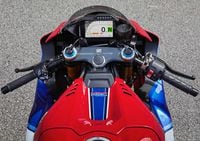
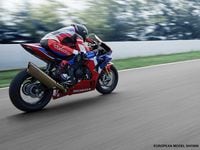

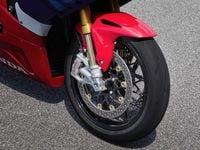
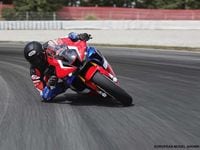
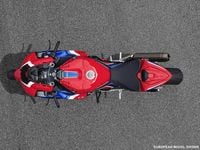
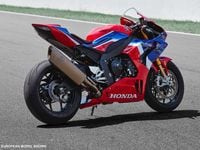
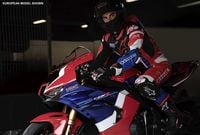
/cloudfront-us-east-1.images.arcpublishing.com/octane/GTCXACQGJ5HAPDTGWUQKDEH44E.jpg)
/cloudfront-us-east-1.images.arcpublishing.com/octane/S35YGSEMEZB4BLTDJTSZPF4GLA.jpg)
/cloudfront-us-east-1.images.arcpublishing.com/octane/5UOT6HPX2JFMRJAX6EH45AR4MQ.jpg)
/cloudfront-us-east-1.images.arcpublishing.com/octane/OKWOJWAKP5EP3OACCRRWPCIX2Q.jpg)
/cloudfront-us-east-1.images.arcpublishing.com/octane/2WF3SCE3NFBQXLDNJM7KMXA45E.jpg)
/cloudfront-us-east-1.images.arcpublishing.com/octane/G4MG6OUCJNBSHIS2MVVOTPX65E.jpg)
/cloudfront-us-east-1.images.arcpublishing.com/octane/IIGGWFOTOJGB7DB6DGBXCCMTDY.jpg)
/cloudfront-us-east-1.images.arcpublishing.com/octane/QSTCM6AVEZA5JJBUXNIQ3DSOF4.jpg)
/cloudfront-us-east-1.images.arcpublishing.com/octane/U4I7G625B5DMLF2DVIJDFZVV6M.jpg)
/cloudfront-us-east-1.images.arcpublishing.com/octane/B6XD6LS6IVCQPIU6HXDJSM3FHY.jpg)
/cloudfront-us-east-1.images.arcpublishing.com/octane/ICL63FEDDRDTTMINYICCEYGMDA.jpg)
/cloudfront-us-east-1.images.arcpublishing.com/octane/FCGZHQXRBZFLBAPC5SDIQLVF4I.jpg)
/cloudfront-us-east-1.images.arcpublishing.com/octane/WNOB6LDOIFFHJKPSVIWDYUGOPM.jpg)

/cloudfront-us-east-1.images.arcpublishing.com/octane/X33NU3E525ECRHXLNUJN2FTRKI.jpg)
/cloudfront-us-east-1.images.arcpublishing.com/octane/6KKT5NNL2JAVBOXMZYS5ZO76YA.jpg)
/cloudfront-us-east-1.images.arcpublishing.com/octane/J5RKG5O455GMPGQRF2OG6LRT7A.jpg)
/cloudfront-us-east-1.images.arcpublishing.com/octane/GX2CIZKQVRH2TATDM26KFG2DAE.jpg)
/cloudfront-us-east-1.images.arcpublishing.com/octane/ZWIDYSAKQZHD5BHREMQILXJCGM.jpg)
/cloudfront-us-east-1.images.arcpublishing.com/octane/CYUHJZCTSJCH3MRAQEIKXK7SCQ.jpg)
/cloudfront-us-east-1.images.arcpublishing.com/octane/LKOFINY56FCXJCANJ5M7ZDQUBY.jpg)
/cloudfront-us-east-1.images.arcpublishing.com/octane/4NBPDACMWJH63JQYJVK3QRBDZI.jpg)
/cloudfront-us-east-1.images.arcpublishing.com/octane/KKHQHRR3FJGX7H2IPU6RALMWG4.jpg)
